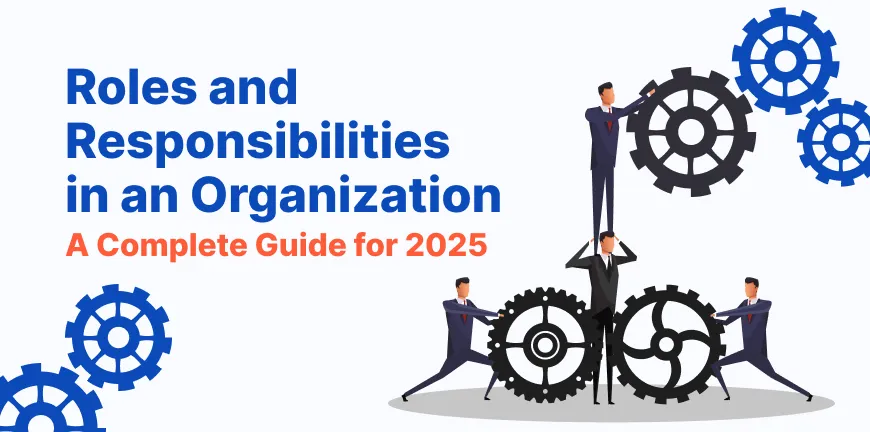
The Difference Between Talent Acquisition and Recruitment
27/10/2025
Hiring Trends in Tier‑2 and Tier‑3 Indian Cities: Tech Impact and Opportunity
27/10/2025- What Are Roles and Responsibilities in an Organization?
- What is the Importance of Roles and Responsibilities in an Organization?
- 11 Key Types of Roles and Responsibilities Across Organizational Levels
- What are the Benefits of Well-Defined Roles and Responsibilities?
- What are the Challenges in Defining Roles and Responsibilities in an Organization?
- What are the Best Practices to Define Roles and Responsibilities?
- What are the Examples of Roles and Responsibilities?
- What is the Future of Roles and Responsibilities in 2025?
- Conclusion
- Key Takeaways
- Frequently Asked Questions (FAQs)
“Clarity of purpose and roles is what empowers teams. When people know why they do what they do, and what they’re accountable for, innovation happens naturally.”- Satya Nadella, CEO of Microsoft.
Are your employees’ roles and responsibilities well chalked out according to the business vision, or are you following a ‘horses for courses’ strategy?
Employee disengagement causes nearly $8.8 trillion in losses for companies across the globe, with ‘role ambiguity’ being a major contributing factor. Every Organisation must ensure that roles are responsibilities are properly defined, and the right person is given the right role to prevent conflicts and create a cohesive workplace. Let’s create a wholesome roles and responsibilities guide to help you make better decisions and strategies that will lead to better outcomes from a 360 perspective.
What Are Roles and Responsibilities in an Organization?
Roles and Responsibilities are the two faces of the same coin, where a role defines a specific position or function within an organisation. In contrast, responsibilities are a set of tasks assigned to a role to achieve the desired outcomes that contribute to the company’s business objectives.
Example: In an IT company, a role defined by the company as a “software developer” will be assigned, with responsibilities including writing code to develop software or applications, testing the code for bugs, and fixing them, etc.
Let’s take another example. Say a company hires an experienced candidate as a ‘project manager.’ This is a diversified role that necessitates the employee to have both technical acumen and people management skills. The responsibilities in these types of roles include project planning, creating a cost-effective budget & preparing a timeline, assigning tasks, managing the team, overseeing operations, coordinating with stakeholders, and handing over the final product to the client.
The leadership team must take complete ownership of clearly defining roles and responsibilities in an organization to maximise the business potential. A 2025 study by the IBM Smarter Workforce Institute found that employees with high role clarity are 53% more efficient and 27% more likely to stay with their organization over three years.
What is the Importance of Roles and Responsibilities in an Organization?
Here are 5 reasons that shed light on the importance of roles and responsibilities in an organization:
1. Enhances Organizational Clarity
Clearly defining roles and responsibilities in an organization eliminates ambiguity, ensuring employees are well aware of what they must do to achieve business goals with minimum fuss. According to surveys, Work performance is reported to increase by 25% when roles are clear. This structured clarity brings accountability at the forefront, reduces duplication of effort, & improves operational efficiency across departments. This absolute approach ultimately drives better teamwork and helps companies accelerate their growth and move ahead.
2. Improves Productivity and Efficiency
When the workforce understands & acknowledges their defined responsibilities, they can focus on delivering specific outcomes. This reduces task time, accelerates decision-making, & enhances individual & overall team performance. A clear structure also enables managers to allocate resources strategically for maximum productivity.
3. Strengthens Collaboration & Teamwork
Clearly assigned roles and responsibilities in an organization build trust & reduce conflicts among employees (employee to employee and employee to manager). Teams can collaborate more effectively, complementing each other’s strengths. This structured coordination fosters smoother workflows, better communication, & a unified approach to achieving shared organizational objectives.
4. Boosts Accountability and Performance
With well-defined duties and responsibilities, employees take ownership of their tasks. This accountability encourages proactive problem-solving, performance tracking, & personal growth. It also enables managers to set measurable KPIs, assess results accurately, & reward high-performing employees effectively.
5. Enables Scalability and Growth
As organizations expand, structured roles and responsibilities help maintain operational stability. Clearly defined function roles allow easy onboarding, process replication, & smoother role transitions, ensuring the company can scale efficiently without losing its strategic direction or operational control.
11 Key Types of Roles and Responsibilities Across Organizational Levels
Here are 11 key types of roles and responsibilities necessary to smoothly run business operations and achieve the best outcomes:
1. Executive Leadership (C-Suite)
Executive leaders set the strategic direction, define long-term business objectives, & ensure the organization achieves sustainable growth. They represent the company to investors, regulators, & the market while nurturing a strong internal culture. The average CEO tenure in the Fortune 500 has increased recently, reaching approximately 7.4 years, which has led to improved productivity and higher loyalty.
Key Responsibilities:
- Develop & deploy long-term business vision, goals & strategies.
- Oversee financial performance & operational efficiency.
- Ensure alignment across all business units.
- Build leadership pipelines & succession plans.
- Champion innovation & risk management.
Success Metrics:
- Revenue growth & profitability.
- Market share expansion
- Organizational stability and innovation index.
- Employee & stakeholder satisfaction levels.
2. Senior Management
Senior managers translate strategic objectives finalised by top leadership into actionable departmental plans. Such leadership roles and responsibilities in an organization ensure that each division or function operates efficiently and aligns with organizational goals. Organizations that invest strategically in leadership development typically report a 25% increase in business outcomes & enjoy 2.3 times greater financial success than their competitors who do not.
Key Responsibilities:
- Create operational plans that align with the business vision.
- Manage departmental budgets & resource allocation.
- Monitor performance against KPIs.
- Lead cross-functional initiatives.
- Coach mid-level managers for leadership readiness.
Success Metrics:
- Achievement of departmental KPIs.
- Budget utilization efficiency.
- Cross-functional project outcomes.
- Employee engagement and retention rates.
3. Department Heads / Functional Leaders
Department heads have duties and responsibilities to manage core business functions (e.g., Marketing, HR, Finance, &Operations). They ensure that their teams deliver specialized outputs that support organizational goals and future endeavours.
Employees whose leaders show concern for their well-being are 3 times more likely to be engaged, and organizations where department heads demonstrate care are 2.3 times better prepared to prevent employee burnout and resulting turnover.
Key Responsibilities:
- Oversee departmental strategy & daily operations.
- Drive team performance and innovation.
- Deploy policies and procedures effectively.
- Report progress to senior management.
- Manage stakeholder and inter-departmental relationships.
Success Metrics:
- Departmental performance against goals.
- Innovation and process improvement outcomes.
- Cost-efficiency and ROI.
- Internal and external stakeholder satisfaction.
4. Project Managers
Project managers lead cross-functional projects, ensuring that deliverables meet scope, time, budget, and quality expectations. Organizations that implement structured project management are 2.5 times more successful and achieve dramatically better outcomes.
Key Responsibilities:
- Define project scope, timelines, & resources.
- Coordinate across teams and vendors.
- Manage risks and escalations proactively.
- Ensure quality standards are met.
- Report progress and ensure stakeholder alignment.
Success Metrics:
- On-time and on-budget delivery.
- Stakeholder satisfaction scores.
- Project ROI or business impact.
- Risk mitigation effectiveness.
5. Team Leaders / Supervisors
Team leaders function as the bridge between employees & management. They oversee day-to-day operations, resolve challenges, & motivate team members to meet goals. When strong leadership practices are in place, projects are 2.5 times more likely to achieve their intended results. In general, only about 35% of projects are completed successfully.
Key Responsibilities:
- Assign tasks and monitor progress.
- Foster team collaboration and morale.
- Provide performance feedback and coaching.
- Escalate issues to management when required.
- Uphold organizational culture and values.
Success Metrics:
- Team productivity and output.
- Reduced error or defect rates.
- Employee engagement and morale scores.
- Timely completion of team goals.
6. Individual Contributors (Specialists)
Specialists or individual contributors execute specific technical or functional tasks. They are critical for operational excellence and quality delivery. ICs are responsible for the actual execution of projects &tasks (e.g., coding, marketing, specialized sales, etc), directly contributing to the delivery of organizational goals.
Key Responsibilities:
- Deliver high-quality work outputs.
- Collaborate effectively with teams.
- Continuously upskill & innovate.
- Adhere to timelines and standards.
- Contribute to problem-solving & improvement initiatives.
Success Metrics:
- Quality and accuracy of outputs.
- Timeliness of task completion.
- Individual performance ratings.
- Innovation or improvement contributions.
7. Human Resources Roles
HR professionals shape workforce strategy, talent acquisition, employee engagement, & organizational culture to support business goals. Organizations that implement proactive and strategic HR policies experience higher workforce productivity, reduced turnover costs, & enhanced innovation, all contributing to sustainable financial performance.
Key Responsibilities:
- Manage recruitment, onboarding, & retention.
- Drive learning and development initiatives.
- Ensure legal and compliance adherence.
- Build engagement and well-being programs.
- Partner with leadership on workforce planning.
Success Metrics:
- Time-to-hire and retention rates.
- Employee engagement scores.
- Training ROI and skill enhancement.
- Compliance and audit performance.
8. Finance & Accounting Roles
Finance teams maintain the organization’s financial health through budgeting, forecasting, compliance, and strategic financial planning. Effective financial management practices in companies can lead to a potential increase of up to 20% in cash flow and profitability.
Key Responsibilities:
- Manage accounts, budgets, & financial reporting.
- Analyse costs and profitability.
- Ensure compliance with financial regulations.
- Support investment & capital planning.
- Enable cost optimization.
Success Metrics:
- Budget adherence & cost savings.
- Accurate and timely financial reporting.
- Profit margins and cash flow stability.
- Audit and compliance results.
9. Operations & Supply Chain Roles
Operations professionals ensure business activities run smoothly, delivering products or services efficiently and at scale. Companies that systematically redesign their supply chain networks see cost reductions usually in the range of 5% to 15% of total supply chain costs.
Key Responsibilities:
- Oversee production and delivery processes.
- Implement quality and safety standards.
- Optimize workflows and resource utilization.
- Manage supplier and logistics networks.
- Drive operational excellence programs.
Success Metrics:
- Operational efficiency ratios
- Cost per unit reduction
- On-time delivery rates
- Quality and defect metrics
10. Marketing & Sales Roles
Marketing and sales teams drive revenue growth by attracting, converting, and retaining customers through strategic campaigns and relationship-building. Companies that align their sales and marketing departments are 15% more profitable and grow 19% faster.
Key Responsibilities:
- Develop and execute marketing campaigns.
- Generate leads and convert sales.
- Analyse market trends and customer insights.
- Build brand awareness and loyalty.
- Align with product and customer teams.
Success Metrics:
- Lead conversion rates.
- Revenue growth and customer acquisition cost.
- Brand awareness & engagement metrics.
- Sales pipeline health and forecasting accuracy.
11. IT & Digital Transformation Roles
IT and digital teams enable business continuity, cybersecurity, & digital innovation through technology adoption & infrastructure management. An average of 63% of executives worldwide reported a positive impact on profitability or performance from digital transformation efforts over a recent 24-month period.
Key Responsibilities:
- Maintain and secure the IT infrastructure.
- Implement new digital tools and systems.
- Support cross-functional digital initiatives.
- Ensure data privacy and security compliance.
- Drive process automation and efficiency.
Success Metrics:
- System uptime and performance.
- Cybersecurity incident reduction.
- User satisfaction and adoption rates.
- ROI from technology investments.
What are the Benefits of Well-Defined Roles and Responsibilities?
Here are 5 key benefits of diligently defining roles and responsibilities in an organization:
1. Accelerates Strategic Alignment
Clearly structured roles and responsibilities help employees understand how their contributions & efforts directly impact broader business objectives. When individual responsibilities align with organizational goals and teams work with a shared purpose, it drives faster execution of strategies and ensures company-wide initiatives move in the same direction.
2. Drives Consistency in Execution
Accurately defining roles and responsibilities in an organization creates standardized ways of working. This minimizes variations in output quality & ensures uniform execution across teams and locations. Such consistency elevates customer experience, strengthens brand reputation, & enables businesses to maintain reliable operational performance at scale.
3. Strengthens Risk Management & Compliance
When roles and responsibilities in an organization are clear, there’s better visibility into who owns critical processes and compliance touchpoints. This structured accountability reduces the likelihood of errors, regulatory lapses, or missed deadlines. Such diligent approaches mitigate operational risks and ensure stronger governance frameworks.
4. Empowers Talent Development & Career Growth
Employees with clear roles can focus on mastering their skills, pursuing targeted training, & progressing within defined career paths. This role clarity boosts engagement, enhances retention, & helps organizations build strong internal leadership pipelines to support long-term business growth.
5. Enhances Agility During Change
Well-defined duties and responsibilities act as a stable framework during periods of change, such as restructuring, expansion, or digital transformation. Teams adapt faster because expectations are clear, decision paths are defined, & operational disruptions are minimized, enabling smoother transitions and sustained momentum.
What are the Challenges in Defining Roles and Responsibilities in an Organization?
Here are 5 key challenges in defining roles and responsibilities within an organization:
1. Overlapping Functions and Ambiguity
Many types of roles evolve organically without proper structure, leading to overlaps between departments. This creates confusion, duplicated efforts, & unclear accountability. Also, employees may struggle to understand their boundaries, resulting in inefficiencies, delayed decisions, & workplace conflicts that negatively affect overall performance.
2. Resistance to Change
Redefining function roles often disrupts existing comfort zones. Moreover, employees may resist new duties and responsibilities or reporting structures, fearing loss of control or increased workload. This cultural pushback can slow down implementation & impact the effectiveness of role clarity initiatives.
3. Rapid Organizational Growth
As companies scale, roles that once worked for small teams may become obsolete. Responsibilities expand faster than structures can cope, creating gaps or blurred ownership. Without timely realignment, growth can outpace clarity, resulting in operational & communication breakdowns.
4. Lack of Clear Communication
Even well-designed roles fail when expectations aren’t communicated diligently. Vague JDs, unclear reporting lines, or inconsistent messaging led to misalignment. Additionally, employees may interpret responsibilities differently, causing confusion, errors, & friction between teams and leadership.
5. Evolving Business Needs
Modern organizations operate in fast-changing environments. Shifting priorities, new technologies, and market dynamics require roles to be continuously redefined. Also, without agile frameworks, roles and responsibilities can become outdated, misaligned, or irrelevant, impacting agility and slowing organizational progress.
What are the Best Practices to Define Roles and Responsibilities?
Clearly defining roles and responsibilities is essential for building an efficient, accountable, & collaborative organization. When expectations are transparent, employees can align their efforts with business goals more effectively. Best practices go beyond creating job descriptions & build a structured framework that supports performance, accountability, scalability, & organizational growth. Here are the 5 best practices organisations must follow to accurately define roles and responsibilities.
1. Conduct a Thorough Role Analysis
Start by analysing the organization’s structure, workflows, and strategic goals. Understand what each team contributes and identify skill gaps or overlaps. Engaging department heads & employees during this process ensures that roles are designed with practical, operational relevance and aligned to both short-term priorities and long-term business objectives.
2. Link Roles to Strategic Goals
All types of roles within an organization should have a clear connection to business objectives. Define how each position contributes to revenue growth, customer satisfaction, innovation, or efficiency. This strategic alignment helps employees see purpose in their work, improves accountability, & ensures the business moves in a unified, goal-driven direction.
3. Create Clear and Measurable Deliverables
Go beyond broad job titles and define responsibilities in specific, measurable terms. Outline key tasks, performance metrics, reporting lines, & decision-making authority. This clarity minimizes ambiguity, empowers employees to take ownership, & allows managers to track performance objectively through KPIs and structured evaluation frameworks.
4. Maintain Flexibility and Adaptability
Roles must evolve as business needs change. Regularly review and update responsibilities to match organizational growth, market shifts, and new technologies. Building adaptable frameworks ensures employees can embrace change confidently, preventing roles from becoming outdated or misaligned with emerging opportunities and strategic initiatives.
5. Communicate and Document Effectively
Clear communication is as critical as well-structured roles. Ensure responsibilities are documented in accessible formats and communicated across levels. Also, conduct orientation sessions, team briefings, and feedback loops to reinforce understanding. This transparency fosters alignment, builds trust, and eliminates confusion across departments and reporting hierarchies.
What are the Examples of Roles and Responsibilities?
Here are a few examples of roles and responsibilities that will be deployed by companies in 2025 based on current business market needs.
1. Digital Transformation Manager
These types of roles are responsible for driving technology adoption & process automation. A digital transformation manager oversees digital strategy, evaluates tools like AI and cloud solutions, & ensures smooth integration with existing workflows. Individuals in such roles team up with cross-functional departments to enhance operational efficiency & customer experience through innovation.
2. People Experience Specialist
Such function roles focus on improving employee engagement, wellness, & culture. People experience specialists design programs for hybrid work, mental health support, & retention. Moreover, they partner with leadership team members to deploy people-centric strategies that build trust, boost productivity, & align with organizational values and DEI initiatives.
3. Sustainability & ESG Officer
Sustainability & ESG Officers develop and implement strategies to reduce carbon footprint, ensure regulatory compliance, & promote ethical business practices. They monitor ESG metrics, prepare sustainability reports, and collaborate with different departments to integrate environmental and social responsibility into everyday business operations.
4. AI & Automation Strategist
An AI & automation strategist identifies areas for intelligent automation and AI deployment. Employees in such roles work closely with tech and business teams to improve efficiency, minimize manual work, and optimize decision-making. Moreover, such roles ensure ethical use of AI, data privacy, & compliance with evolving regulations.
5. Cybersecurity Risk Analyst
Cybersecurity risk analysts monitor and assess potential digital threats, implement risk mitigation plans, and ensure data security across cloud and hybrid systems. They form a collaboration with IT and compliance teams to enhance resilience, train staff on security protocols, and maintain business continuity.
What is the Future of Roles and Responsibilities in 2025?
The future of roles and responsibilities in 2025 is shaped by rapid digital transformation, hybrid work models, & growing regulatory demands. Function roles are becoming more strategic, tech-driven, and people-centric. Additionally, employees are expected to be agile, leveraging AI and automation to streamline operations while focusing on innovation and customer experience. Moreover, roles now demand cross-functional collaboration, data literacy, & a strong acumen and expertise in sustainability and compliance.
Leadership roles and responsibilities in an organization are evolving to emphasize emotional intelligence and inclusive growth. Traditional job descriptions are being replaced with dynamic, skill-based responsibilities that adapt to change. Moreover, organizations prioritizing continuous learning & flexible role structures will stay competitive, ensuring their workforce remains future-ready in an increasingly digital and globalized business environment.
Conclusion
Roles and responsibilities in 2025 are centred around agility, innovation, and digital empowerment. As technology reshapes business landscapes, organizations are redefining roles to be multi-dimensional and outcome-focused, blending technical expertise with strategic thinking.
Employees are expected to collaborate seamlessly across functions, while leaders prioritize adaptability and people-first approaches. This evolution ensures businesses stay resilient in fast-changing markets.
This comprehensive guide will help companies devise better strategies to clearly define roles and responsibilities and build a cohesive work culture that brings the best out of every employee, leading to continued business growth and innovation.
Alp Consulting helps companies stay ahead by providing end-to-end hiring solutions for every level, from entry-level positions to C-suite roles. Build a workforce that’s not just job-ready but future-ready, driving innovation and long-term business success.
Key Takeaways
- Clear roles and responsibilities eliminate ambiguity, enhance accountability, and boost overall organizational efficiency.
- Defined roles strengthen collaboration, reduce conflicts, and create a unified, goal-oriented workplace culture.
- Role clarity improves productivity, speeds decision-making, and supports strategic business alignment.
- Evolving roles emphasize agility, innovation, digital transformation, and continuous employee upskilling.
- Future-ready organizations link well-defined responsibilities with sustainable growth & competitive advantage.
Frequently Asked Questions (FAQs)
1. What are the roles and responsibilities?
Roles define a position or function, while responsibilities are specific tasks and duties associated with a particular role required to achieve organizational objectives effectively.
2. What are roles vs responsibilities?
Roles outline what someone is expected to do, whereas responsibilities explain how and what actions must be taken to fulfil that role.
3. How to write roles and responsibilities in a CV?
Use action verbs, highlight measurable results, focus on core contributions, & align responsibilities with the desired JD requirements.
4. What are the four main roles in a team?
The four main roles in a team include leader, facilitator, contributor, and supporter, each ensuring direction, collaboration, execution, and team alignment.
5. Why are roles important?
Clearly defining roles and responsibilities in an organization creates structure, reduces confusion, improves accountability, boosts productivity, and aligns individual efforts with organizational goals.
6. What are examples of organizational roles and responsibilities?
Examples of organizational roles and responsibilities include a project manager leading teams, HR managing talent, finance overseeing budgets, & IT ensuring systems run securely and efficiently.
7. How often should job roles and responsibilities be updated?
Roles and responsibilities should be reviewed at least annually or during major organizational, technological, or strategic business changes.
8. What happens if roles and responsibilities are not clear in an organization?
Unclear roles lead to confusion, overlapping work, reduced accountability, lower productivity, miscommunication, & misalignment with business goals.

Amit Saproo
Amit Saproo is the Head of Operations at ALP Consulting with nearly 17 years of experience in Executive Search, RPO, Leadership, and IT & Engineering recruitment. He leads nationwide recruitment programs across Technology, BFSI, and R&D domains, driving strategic hiring solutions for diverse client needs. Amit excels in building and managing high-performance teams that deliver scalable, end-to-end recruitment and consulting services.




